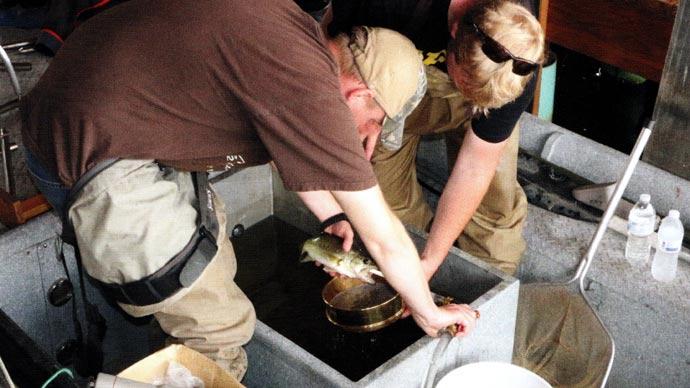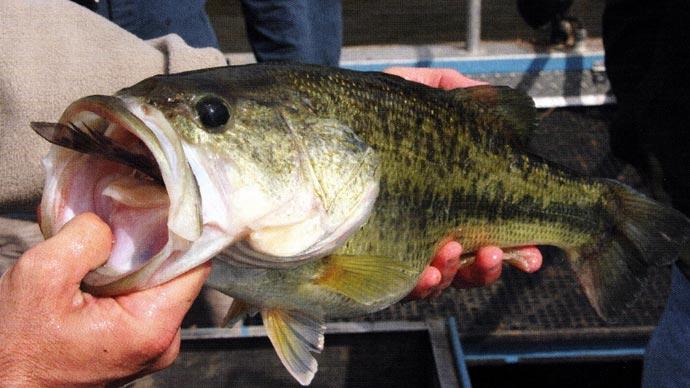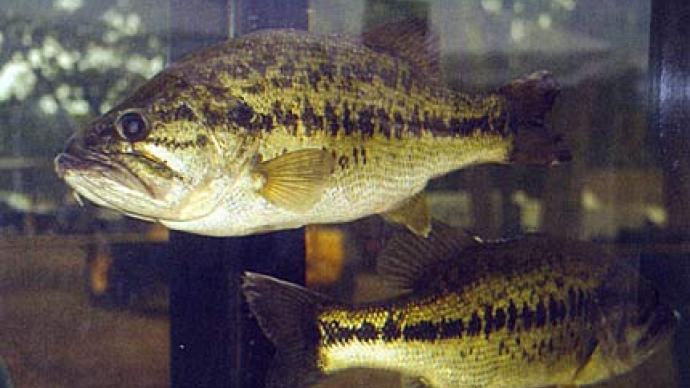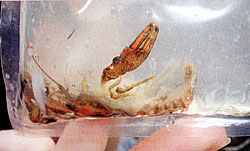
Every year in one of my fisheries courses students perform diet analysis on several types of fish from a local pond we are studying. I usually introduce the topic by asking the class "How many of you have ever had a stomach lavage'?" Not a single hand goes up. Then I ask, "Have any of you ever had your stomach pumped'?" Not surprisingly, at least one person in a class of 15-20 will usually raise a hand. I won't take you into some of the stories and details that follow... you get the idea. We hear this on hospital TV shows like ER when a doctor says "Give me a gastric lavage ... stat."
To find out what your fish are eating, let's bring the fish ER pondside.
A lavage is probably a more appropriate term when we talk about this technique. Stomach pumping suggests that we take a suction pump, like a vacuum, and suck out the contents of the fish's stomach so that we can see what it is eating. The opposite is true. A lavage is stomach flushing, which is what we are doing here. Taking water and forcing it into a fish stomach washes out what the fish had for dinner.
I was first introduced to this technique as a kid fishing for trout on the banks of the Delaware River. Every nice sunny day, a group of wise, sage (which actually means "over 75 years old") fly fishermen would sit on the grassy bank of the river discussing the "hatch." Every once in a while one of those geezers would make it off the bank and catch a trout. They gingerly kept the fish in the water in the landing net and guided it to the bank. One man held the fish in the net and another reached into his vest and whipped out what looked like a modified turkey baster, with a thin tube protruding off the end. He filled it with river water, guided the tube gently down the trout's throat, squeezed the baster bulb, and out came fish lunch, which usually included a myriad of mayflies, stoneflies, caddisflies and an occasional sculpin or baby trout! Baby trout! Cannibalism! Light bulbs went off in my 12 year old brain, firing up all kinds of new ways to catch these wary trout.
|
Image

|
If you want to build a stomach "pump" to check your fish and match your "hatch," here's how. Building four or five is as easy as building one of them. I tend to lose things. If you have only one, you'll never be able to find it when you want to use it. The first thing you need is a large syringe (I've moved past the turkey baster). Your local veterinarian will have some of these and so will your local friendly farmer. Horse people should have a bunch of them, too. Sometimes farm folk throw them out, you may need to ask a few people to save them for you. Make sure the syringe holds at least 75- 100cc. I like even bigger ones if you can find them. If you can't find one, get your hands on a vet catalog or go online and order one. Barter for a few of them and get started.
Take that syringe down to a hardware store and look at their inventory of tubing. Tubing usually comes on large rolls. If you don't see it, ask. Most good hardware stores will have some. Buy the size that fits best on the end of the syringe. A few feet of the tubing is plenty. I usually make two sizes of these pumps, one for small fish like panfish, using aquarium airline tubing (3/16" outside diameter) and then a larger one using bigger tubing for bass. As you shop for tubing, bend and twist it. Some tubing is more rigid than others. You don't want it to be too flexible, like wet spaghetti, but not rigid like a straw either. You want something flexible enough to snake down a fish's throat and not puncture its gut. For small fish, the length of tube attached to the syringe can be six inches or so in length. I have found that the perfect tubing is a bit aged, not brittle and still a little pliable. Make sure there are no sharp surfaces on the tubing from your cuts.
As you learn, practice on fish that aren't your favorites. I will get to problems in a minute. Personally, being a fisheries biologist and teacher, I like to
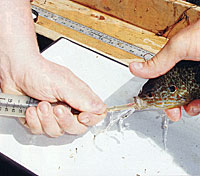
anesthetize fish, first. It is easier on them and you. If you want to knock them out first, I would do it with Finquel (MS-222) or with a few drops of clove oil (from the health food store) emulsified in a little bit of ethanol. But, practically, most pondmeisters don't need to knock them out.
To flush the stomach, like the stream-side old timers with the turkey baster, it's best to use two people. One person controls the fish and the other one runs the syringe. Fill the syringe full of clean water. Hold the syringe pointing up and push the plunger a bit to get out any extra air (again, similar to those TV shows, where someone is about to get a scary shot and the doctor is squirting some unknown fluid into the air from a needle). Have the fish handler open the fish's mouth. Now, this is the most critical part ...the syringe man then looks down the fish's mouth and guides the tubing exactly down the throat of the fish.
DANGER! Be careful not to push the tubing out the gills, or too far down the stomach! You will encounter a little resistance just before the tubing slides into the stomach, but do not use excessive force. The fish's throat has a tight muscle at the top. Fish stomachs are a bit elastic, but don't push the tubing in too far. Once you are "in" (after a few practices, you will get the feel) the fish handler should angle the fish mouth down, tail up, with the mouth over a tray or plastic bag to catch stomach contents. Now, syringe person ... push that plunger! In an ideal world, water will be forced into the stomach and contents will be flushed out the throat. I like to move the syringe in and out a little (1 inch?), keeping the tubing end in the stomach to give contents room to get by the tubing on the way out. As you push the water inside the fish you should feel the stomach swell like a water balloon, the collapse as the water exists. Flush the stomach at least twice. After pumping, look down the throat and see if anything is lodged in there. You may see something (like a fish tail or crawfish) that can be easily grabbed with a set of tweezers or even fine needle nose pliers.

Foster (1977) documented that this technique (when done properly) is almost 100% effective at removing stomach contents. In his study, stomachs were dissected after pumping to prove effectiveness. Really big fish are harder to do. You are limited by the size of the syringe and the tubing. A large bass will take several 100cc syringes in his stomach and not regurgitate anything. Not good. In this case, you need a larger syringe system (or even small water pump) and a tube approaching the size of a garden hose. My recommendation to you is do not do this with your large bass. Stick with bass less than 15" with this technique.
Have I killed fish doing this? Yes. How? The most common error, especially with rookies, is missing the esophagus on tube insertion and hitting a gill, causing a fatal bleed. I have also blown out a few stomachs by forcing the syringe plunger too hard. There's no need to jet the water in. The more you do it the better you get at it.
I teach kids who have never held a fish before to do this all the time in our field work. After doing just a few fish, their confidence greatly improves. Yours will too. I have never met a fisherman who was not interested in what his quarry was eating. Kids love this stuff. Their first reaction to fish puke is usually, "Yuck!" then they move closer and look at it, "Awe that's gross!" then "Cool! Can we do it again?"
Mark Cornwell is a fisheries professor at SUNY-Cobleskill in Cohleskill, New York. His passion is raising walleye and the I.Q. of fisheries students in the Northeast.
Reprinted with permission from Pond Boss Magazine

